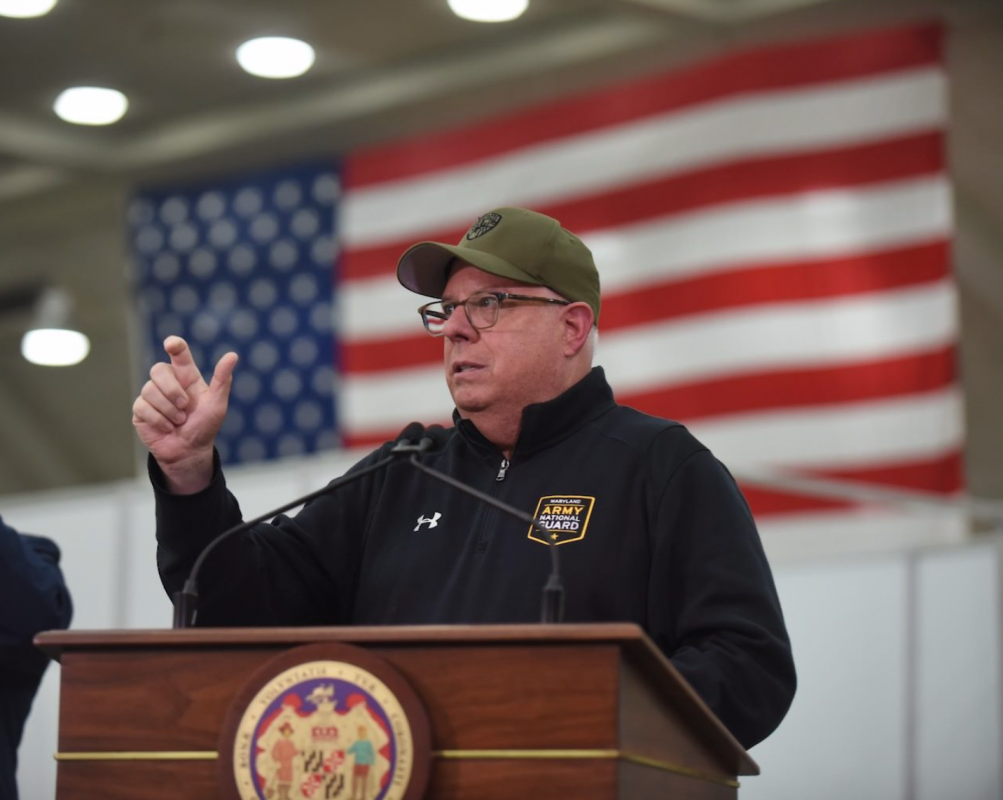
Governor Larry Hogan put forth plans for a gradual reopening of the state Wednesday afternoon amid what he described as “very real reasons for hope and optimism” in Maryland’s ongoing battle with COVID-19.
The number of statewide deaths from the novel virus increased by 47 on Wednesday—the single-highest daily tally to date—as Maryland also added 64 probable fatalities to the list of victims, pushing the state total past 400.
Beginning yesterday, the state announced that it will start reporting both confirmed and probable deaths. Deaths are listed as probable COVID-19 fatalities if the death certificate lists the virus as the cause of death, but it has not yet been confirmed by a laboratory test.
Gov. Hogan announced in Annapolis that Maryland officials have been consulting with doctors and public health experts over the last several weeks to develop a plan for the reopening of the state as predictive models for the number of cases and deaths in the state have improved.
“It is too soon to say, ‘Yes, we’re going to start opening already.’ We’re not going to flip the light switch,” Hogan said at a press conference, adding, “It’s not too soon to start laying out what that will look like and maybe start considering when first steps might be.”
Hogan also gave notice of an executive order Wednesday that requires face coverings for anyone inside a retail business, including grocery stores, pharmacies, and convenience stores, or when riding any form of public transportation in the state. The order mandates retail establishments require staff to wear face coverings and put appropriate social distancing measures in place, as well. It goes into effect on Saturday, April 18 at 7 a.m.
Hogan’s announcements come as Los Angeles Mayor Eric Garcetti, New York Mayor Bill de Blasio, and others cautioned that it may be some time before large gatherings like sporting events or concerts may resume.
“It’s difficult to imagine us getting together in the thousands anytime soon, so I think we should be prepared for that this year,” Garcetti told CNN’s Wolf Blitzer Wednesday. “I think we all have never wanted science to work so quickly,” he continued. “But until there’s either a vaccine, some sort of pharmaceutical intervention, or herd immunity, the science is the science. And public health officials have made very clear we have miles and miles to walk before we can be back in those environments.”
Hogan said the state’s reopening plans will be based on expanding testing capacity, boosting hospital surge capacity, increasing the state’s supply of personal protective equipment for healthcare workers, and dramatically building out Maryland’s contact tracing operation. He said the state has expanded testing capacity over the past month, and is on track to more than triple current capacity and eventually perform up to 10,000 tests per day.
Maryland has also state entered into a separate agreement with Abbott Labs to acquire antibody tests that could identify those who were infected with the virus, but have recovered.
Today I announced that because of early and aggressive actions and the extraordinary sacrifices of Marylanders, we are now in a position to begin planning the safe and gradual rollout of our state’s recovery phase.
Details here: https://t.co/jx6sMDvZjz — Governor Larry Hogan (@GovLarryHogan) April 15, 2020
In terms of Maryland’s contact-tracing operation, the state hopes to be able to investigate each positive test for the virus and make sure that those individuals remain in isolation for the duration of their illness.
Currently, Maryland has approximately 250 people statewide conducting contact tracing to identify those who have likely been exposed to the virus—with a goal of quadrupling its contact tracing network to at least 1,000 workers by utilizing additional state employees and hiring outside contractors. One issue in determining who to test, of course, is that many infected with COVID-19 and contagious are asymptotic. A mass vaccine for the virus is still expected to be 12-18 months away.
Baltimore Mayor Bernard C. “Jack” Young’s office confirmed Wednesday that 129 residents and 29 staff members at the FutureCare nursing home in Lochearn have tested positive for coronavirus. It is the state’s biggest outbreak. FutureCare spokeswoman Holly O’Shea said the nursing home proactively implemented a process known as ‘widespread surveillance testing’ at the site. The testing monitors the intensity and spread of the disease in a community with high transmission.”
The mayor’s office and FutureCare said many of the people who have tested positive are not symptomatic, but the testing allows the medical staff to monitor and isolate positive patients. Johns Hopkins has provided staff guidance on controlling the infectious disease.
According to Baltimore City Health Commissioner Dr. Letitia Dzirasa, the first case at the nursing home was found March 31. Dzirasa said most of test results came in Sunday and her office “will continue to monitor the situation at this facility.”
Hogan said earlier this week that coronavirus outbreaks have been confirmed in more 90 nursing home facilities in the state.
Hogan provided no timeline for and easing of restrictions in the state for non-essential businesses and social gatherings. He cautioned that Maryland likely has not yet reached its peak in terms of its number of daily cases and deaths from the virus.
“Fortunately, because of the early and aggressive actions and because of the extraordinary sacrifices of Marylanders, we are now in a position to move from containment and mitigation to planning the gradual rollout of our recovery phase,” Hogan said. “There are some very real reasons for hope and optimism right now and there is clearly a light at the end of this tunnel, but exactly how and when we will get to that light is going to be up to each and every one of us.”
He continued, emphasizing the importance of keeping social-distancing measures in place: “Right now while our numbers are still climbing and we are still heading up that curve, not down, it is absolutely critical for Marylanders to stay home, to continue avoiding crowds and gatherings, and to aggressively practice social distancing.”
